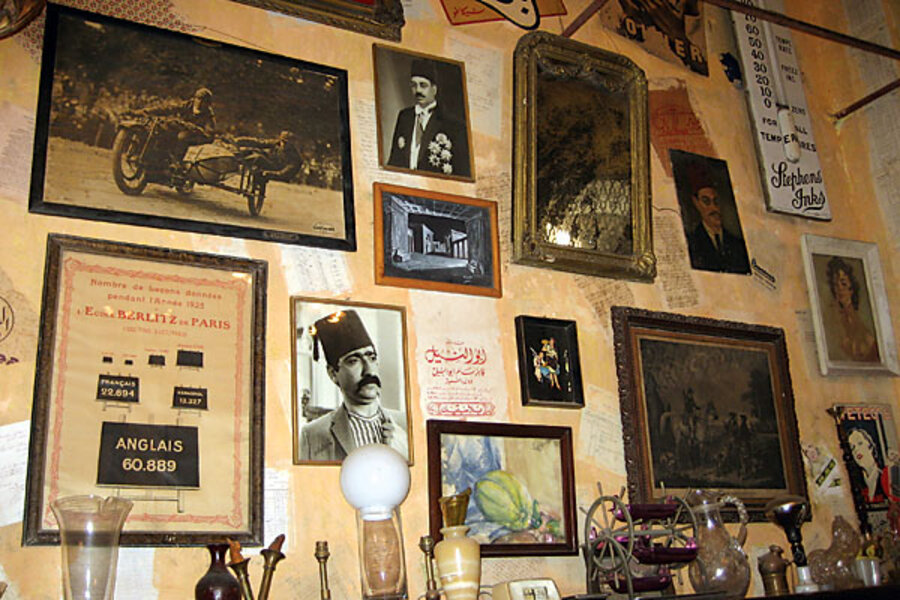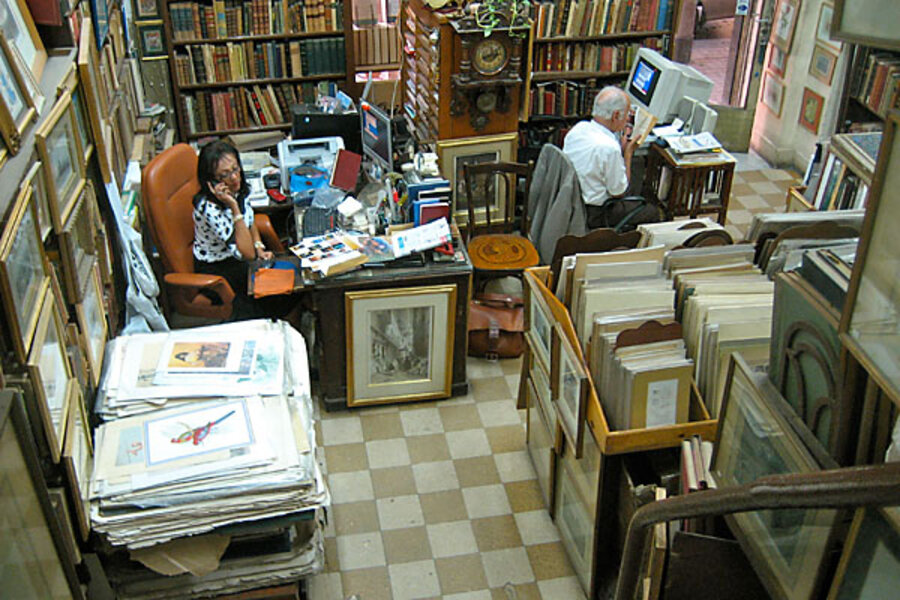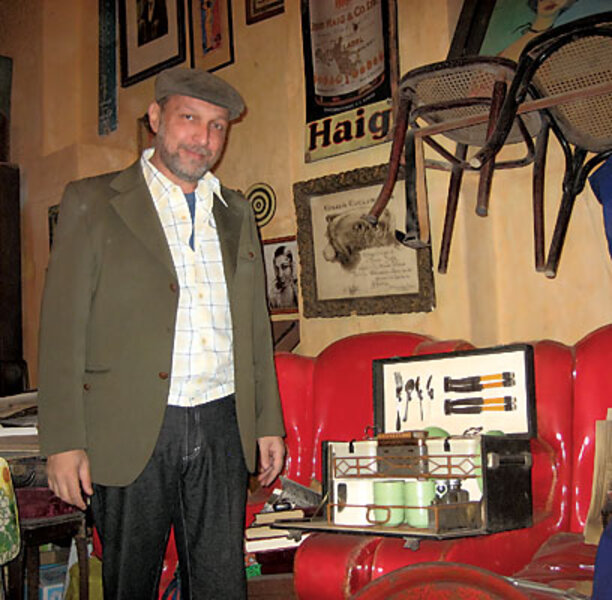Egypt salvages its modern treasures
Loading...
| Cairo
Amgad Naguib is sitting in his garagelike storage space on a side street in the dusty belle epoque heart of downtown Cairo looking to buy junk. “Bikya!” the junk seller yells from his cart on the street outside, which means reusable rubbish. “I get a lot of treasures from bikya,” Mr. Naguib, an artist and collector, says from his garage, which is stuffed with old furniture, vintage advertisements, and stacks of papers and photographs from the early 20th century.
Between the vendors who buy and sell junk and the tourist shops that offer overpriced historical keepsakes – Iraqi dinars with Saddam Hussein’s face, fake old photographs, faded postcards – there are other Egyptian collectors, artists, and historians collecting pieces of the past, and not always for profit. Accumulating old objects, whether valuable or not, suggests connection with downtown Cairo’s material past as the area undergoes major changes, from the flight of historic institutions to news of investment-driven gentrification.
The bookstore L’Orientaliste is a remnant of downtown Cairo before the 1952 revolution that ended Egypt’s monarchy. Opened in the 1930s under Jewish owners, the store stocks a vast collection of rare first-edition books on Egypt and the Middle East, many from the genre of Orientalist travelogues that exploded in Europe in the late 19th century with the advent of steamship travel.
Hanging over the bookshelves or stacked on top of them are original lithographs by David Roberts, a Scottish painter who churned out prints of Egypt and Palestine during his travels in the 1840s.
Today L’Orientaliste is a mostly expatriate-leaning model of the bookstore as museum and so it sells its old books and rare maps for a price. A French map of Egypt from the 19th century might cost 2,000 Egyptian pounds (about $360). A Ptolemaic map of the Mediterranean, which owner Nagwa Kamy says is an original print from 1520, cost 5,000 Egyptian pounds (a little over $900). First-edition travelogues, histories of the Holy Land and Victorian expeditions up the Nile, crowd the shelves.
“The previous owner was a tired old man and he got many offers, but he refused to sell,” Ms. Kamy says from behind her desk, piled with books, in the cramped first floor of her shop. “He thought the books would all be thrown out and the place would be turned into a shoe shop.”
She and her husband finally bought the store in 1987. Most of its inventory is the original collection of its Jewish founder, who left Egypt in 1956 after Israel colluded with Britain and France to try to take back the Suez Canal and topple Egypt’s socialist president, Gamal Abdel Nasser.
“When the Europeans left [after the Suez Crisis in 1956], they left in catastrophe,” Kamy says after answering a call in French on her iPhone. “They sold everything they had, flooding markets and shops like this with whole libraries and archives. It happened again in 1967, after [the] war with Israel.”
A few blocks away from Kamy’s shop, Naguib tells his own story of collecting when the markets were flooded with historical items.
“After the infitah” – the “open-door” policy of economic liberalization instituted by President Anwar Sadat in the 1970s – “old downtown, which was packed with things and foreigners, just became offices and companies,” Naguib says.
“Businesses bought up old family apartments and emptied them, flooding the markets with antiques.”
Naguib plans to reopen the space as a kind of gallery to Egypt’s past, in particular the pre-1952 Cairo and Alexandria of King Farouk. Naguib’s collection is a jumble of things – racy film posters; placards in Arabic, French, and Hebrew; old magazines; dresses; and jewelry from the 1940s – each object with Naguib’s own story of how it was found.
“You have to get used to the dust,” he says as he unpacks a stack of Iranian photographs from the 1910s that he recently acquired as a throw-in when he bought a file of Iranian magazines printed in Cairo in the early 20th century.
Naguib does not collect with sales in mind, he says, although he has been collecting and trading antiques since the 1980s.
“I realized I could make a living this way. And I didn’t want to be a banker like my brothers.”
He produces a stack of 300 love letters from two students living in adjacent apartments in the 1950s. The letters talk about family life and continue into the 1960s after the couple married. It is like an in-the-works archive of Cairo’s social history, with artistic appeal.
“I want to project the letters in English and Arabic as an installation,” he says. Later he mentions another project made from what many people consider junk: a map of downtown Cairo through old advertisements.
“I want to archive these things – articles, papers, photographs – for Egyptian history,” he explains. He has friends who are more precise in their collecting. “I have a historian friend who only collects 19th-century photographs of Egypt; he has hundreds of thousands.”
Beyond appealing to history buffs and collectors, the work of accumulating objects from the past – whether rare books or old personal letters – underlines an appreciation for Cairo’s urban and social history at a time when the downtown area is changing, somewhere between flight and renovation.
Major cultural institutions like the American University in Cairo (AUC), central landmarks throughout the 20th century, have moved out to new satellite cities in the desert, following the flight of wealthy Egyptians to gated communities removed from the traffic and pollution of the historic city center.
Meanwhile real estate investments are pouring in to revive the area’s grand old buildings. Downtown Cairo, developed in the late 19th and early 20th century to mimic Europe, was once lauded as a cosmopolitan and architectural “Paris on the Nile.”
A new venture of Egyptian and Gulf investors, Al Ismailia for Real Estate Investments, is leading the buy-up with plans to own dozens of buildings. It aims in the long term to gentrify the downtown area and attract wealthier Cairenes back to the center with restored apartments, offices, cinemas, and restaurants.
“The move of the AUC is a big step backward,” Kamy says. “I wouldn’t think of moving ever, even if [downtown Cairo is] not what it was. My shop is a part of that history."







